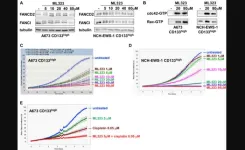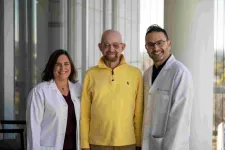(Press-News.org) BOSTON – What causes us to age? New “clocks” developed by researchers may help point to the answers. Investigators from Brigham and Women’s Hospital, a founding member of the Mass General Brigham healthcare system, unveil a new form of epigenetic clock – a machine learning model designed to predict biological age from DNA structure. The novel model distinguishes between genetic differences that slow and accelerate aging, predicts biological age and evaluates anti-aging interventions with increased accuracy. Results are published in Nature Aging.
“Previous clocks considered the relationship between methylation patterns and features we know are correlated with aging, but they don’t tell us which factors cause one’s body to age faster or slower. We have created the first clock to distinguish between cause and effect,” said corresponding author Vadim Gladyshev, PhD, a principal investigator in the Division of Genetics at BWH. "Our clocks distinguish between changes that accelerate and counteract aging to predict biological age and assess the efficacy of aging interventions."
Aging researchers have long acknowledged the link between DNA methylation—alterations to our genetic structure that shape gene function—and its influence on the aging process. Notably, specific regions of our DNA, known as CpG sites, are more strongly associated with aging. While lifestyle choices, like smoking and diet, influence DNA methylation, so does our genetic inheritance, explaining why individuals with similar lifestyles may age at different rates.
Existing epigenetic clocks predict biological age (the actual age of our cells rather than chronological) using DNA methylation patterns. However, until now, no existing clocks have distinguished between methylation differences that cause biological aging and those simply correlated with the aging process.
Using a large genetic data set, first author Kejun (Albert) Ying, a graduate student in the Gladyshev lab, performed an epigenome-wide Mendelian Randomization (EWMR), a technique used to randomize data and establish causation between DNA structure and observable traits, on 20,509 CpG sites causal to eight aging-related characteristics. The eight aging-related traits included lifespan, extreme longevity (defined as survival beyond the 90th percentile), health span (age at first incidence of major age-related disease), frailty index (a measure of one’s frailty based on the accumulation of health deficits during their lifespan), self-rated health, and three broad aging-related measurements incorporating family history, socioeconomic status, and other health factors.
With these traits and their associated DNA sites in mind, Ying created three models, termed CausAge, a general clock that predicts biological age based on causal DNA factors, and DamAge and AdaptAge, which include only damaging or protective changes. Investigators then analyzed blood samples from 7,036 individuals ages 18 to 93 years old from the “Generation Scotland Cohort” and ultimately trained their model on data from 2,664 individuals in the cohort.
With these data, researchers developed a map pinpointing human CpG sites that cause biological aging. This map allows researchers to identify biomarkers causative to aging and evaluate how different interventions promote longevity or accelerate aging.
Scientists tested their clocks’ validity on data collected from 4,651 individuals in the Framingham Heart Study and the Normative Aging Study. They found that DamAge correlated with adverse outcomes, including mortality, and AdaptAge correlated with longevity, suggesting that age-related damage contributes to the risk of death while protective changes to DNA methylation may contribute to a longer lifespan.
Next, they tested the clocks' ability to assess biological age by reprogramming stem cells (transforming specialized cells, like skin cells, back into a younger, less defined state where they can develop into various types of cells in the body). When applying the clocks to the newly transformed cells, DamAge decreased, indicating a reduction in age-related damage during reprogramming, while AdaptAge did not show a particular pattern.
Finally, the team tested their clocks’ performance in biological samples from patients with various chronic conditions, including cancer and hypertension, as well as samples damaged from lifestyle choices like smoking cigarettes. DamAge consistently increased in conditions associated with age-related damage, while AdaptAge decreased, effectively capturing protective adaptations.
"Aging is a complex process, and we still do not know what interventions against it actually work," said Gladyshev. "Our findings present a step forward for aging research, allowing us to more accurately quantify biological age and evaluate the ability of novel aging interventions to increase longevity."
Disclosures: Kejun Ying and Vadim Gladyshev are inventors on a patent application related to the research reported.
Funding: This study is supported by the National Institute on Aging, Impetus grants and the Michael An-tonov Foundation.
Paper cited: Gladyshev V. et al. “Causality-Enriched Epigenetic Age Uncouples Damage and Adaptation.” Nature Aging DOI: 10.1038/s43587-023-00557-0
END
New epigenetic clocks reinvent how we measure age
New models predict biological age more robustly by distinguishing between harmful and adaptive changes during aging
2024-02-14
ELSE PRESS RELEASES FROM THIS DATE:
The roles of USP1 in Ewing sarcoma
2024-02-14
“This study uncovered important roles for USP1 in Ewing sarcoma.”
BUFFALO, NY- February 14, 2024 – A new research paper was published in Genes & Cancer on February 5, 2024, entitled, “Roles of USP1 in Ewing sarcoma.”
Ewing sarcoma is a cancer of bone and soft tissue in children and young adults that is driven by the EWS-ETS fusion transcription factor, most commonly EWS-FLI1.
Researchers Panneerselvam Jayabal, Xiuye Ma and Yuzuru Shiio from The University of Texas Health Science Center previously reported that Ewing sarcoma harbors two populations of cells, ...
New algorithm disentangles intrinsic brain patterns from sensory inputs
2024-02-14
Maryam Shanechi, Dean’s Professor of Electrical and Computer Engineering and founding director of the USC Center for Neurotechnology, and her team have developed a new machine learning method that reveals surprisingly consistent intrinsic brain patterns across different subjects by disentangling these patterns from the effect of visual inputs.The work has been published in the Proceedings of the National Academy of Sciences (PNAS).
When performing various everyday movement behaviors, such as reaching for a book, our brain has to take in information, often in the form of visual input — for example, seeing where the book is. Our brain then has to process ...
A new test could predict how heart attack patients will respond to mechanical pumps
2024-02-14
Every year, around 50,000 people in the United States experience cardiogenic shock — a life-threatening condition, usually caused by a severe heart attack, in which the heart can’t pump enough blood for the body’s needs.
Many of these patients end up receiving help from a mechanical pump that can temporarily help the heart pump blood until it recovers enough to function on its own. However, in nearly half of these patients, the extra help leads to an imbalance between the left and right ventricles, which can pose danger to the patient.
In a ...
Turning back the clock on photoaging skin
2024-02-14
Chronic exposure of human skin to ultraviolet light causes premature aging, or photoaging. As the skin undergoes photoaging, type I collagen bundles, which are found in the dermis beneath the top layer of the skin and provide strength and support to skin, become fragmented. This leads to wrinkles, fragility and loss of support and elasticity.
“The best way to prevent damage to type I collagen by sunlight is to wear sunscreen consistently, daily if possible and particularly when spending time outdoors,” said Frank Wang, MD, the William B. Taylor Endowed Professor of Clinical Dermatology at U-M Medical School.
Experts ...
City of Hope research featuring the successful treatment of the oldest patient to achieve remission for leukemia and HIV published in The New England Journal of Medicine (NEJM)
2024-02-14
LOS ANGELES — City of Hope®, one of the largest cancer research and treatment organizations in the United States, treated the oldest person to be cured of a blood cancer and then achieve remission for HIV after receiving a blood stem cell transplant from a donor with a rare genetic mutation. Research published in NEJM today demonstrates that older adults with blood cancers who receive reduced intensity chemotherapy before a stem cell transplant with donor cells that are resistant to HIV may be cured of HIV infection.
Paul Edmonds, 68, of Desert Springs, California, is the fifth person in the world to achieve remission for acute myelogenous leukemia ...
A lighthouse in the Gobi desert
2024-02-14
Los Angeles, CA (February 14, 2024) — A new study published in the journal PLOS ONE explores the weight great fossil sites have on our understanding of evolutionary relationships between fossil groups—the lagerstätten effect—and for the first time, quantified the power these sites have on our understanding of evolutionary history. Surprisingly, the authors discovered that the wind-swept sand deposits of the Late Cretaceous Gobi Desert’s extraordinarily diverse and well-preserved ...
Paradigm Shift: How a risk-based program is changing health care use and outcomes for children with high-risk asthma
2024-02-14
Le Bonheur’s risk-based innovation program Changing High-Risk Asthma in Memphis through Partnership (CHAMP) significantly decreased health care use related to asthma by targeting barriers to asthma care, according to research published in the Annals of Allergy, Asthma & Immunology. After one year of enrollment in the program, results analyzing 945 children included a 48% reduction in Emergency Department (ED) visits, 68% reduction in inpatient and observation visits, 42% reduction in urgent care visits and 53% reduction in asthma exacerbations. Asthma exacerbations per patient significantly decreased from 2.97 to 1.4.
“Children ...
U of M research advances potential HIV cure strategy
2024-02-14
Published in the Journal of Infectious Diseases Oxford Academic, research led by the University of Minnesota Medical School offers a new avenue of hope in the fight against chronic human immunodeficiency virus (HIV) infection.
The researchers explored the use of Natural Killer (NK) cells aiming to restore their function for better infection control — an approach that could be used in a broader HIV cure strategy as multiple companies are working on mass production of healthy NK cells.
“HIV has really excellent therapies thanks to the unprecedented progress in developing antiretroviral therapy, ...
New review finds Indigenous people more likely to have a stroke
2024-02-14
EMBARGOED FOR RELEASE UNTIL 4 P.M. ET, WEDNESDAY, FEBRUARY 14, 2024
MINNEAPOLIS – Indigenous people may be more likely to have a stroke than non-Indigenous people, according to a systematic review that looked at populations around the world. The review is published in the February 14, 2024, online issue of Neurology®, the medical journal of the American Academy of Neurology.
Researchers looked at countries with a very high Human Development Index, which measures average achievements in three areas: health, knowledge ...
UC Irvine-led research team creates novel rabies viral vectors for neural circuit mapping
2024-02-14
Irvine, Calif., Feb. 14, 2024 — A research team led by the University of California, Irvine has created 20 new recombinant rabies viral vectors for neural circuit mapping that offer a range of significant advantages over existing tools, including the ability to detect microstructural changes in models of aging and Alzheimer’s disease brain neurons.
The study published today online in the journal Molecular Psychiatry, introduced proof-of-concept data demonstrating the power of these new vectors, which express a range of improved ...
LAST 30 PRESS RELEASES:
Neuroscientists devise formulas to measure multilingualism
New prostate cancer trial seeks to reduce toxicity without sacrificing efficacy
Geometry shapes life
A CRISPR screen reveals many previously unrecognized genes required for brain development and a new neurodevelopmental disorder
Hot flush treatment has anti-breast cancer activity, study finds
Securing AI systems against growing cybersecurity threats
Longest observation of an active solar region
Why nail-biting, procrastination and other self-sabotaging behaviors are rooted in survival instincts
Regional variations in mechanical properties of porcine leptomeninges
Artificial empathy in therapy and healthcare: advancements in interpersonal interaction technologies
Why some brains switch gears more efficiently than others
UVA’s Jundong Li wins ICDM’S 2025 Tao Li Award for data mining, machine learning
UVA’s low-power, high-performance computer power player Mircea Stan earns National Academy of Inventors fellowship
Not playing by the rules: USU researcher explores filamentous algae dynamics in rivers
Do our body clocks influence our risk of dementia?
Anthropologists offer new evidence of bipedalism in long-debated fossil discovery
Safer receipt paper from wood
Dosage-sensitive genes suggest no whole-genome duplications in ancestral angiosperm
First ancient human herpesvirus genomes document their deep history with humans
Why Some Bacteria Survive Antibiotics and How to Stop Them - New study reveals that bacteria can survive antibiotic treatment through two fundamentally different “shutdown modes”
UCLA study links scar healing to dangerous placenta condition
CHANGE-seq-BE finds off-target changes in the genome from base editors
The Journal of Nuclear Medicine Ahead-of-Print Tip Sheet: January 2, 2026
Delayed or absent first dose of measles, mumps, and rubella vaccination
Trends in US preterm birth rates by household income and race and ethnicity
Study identifies potential biomarker linked to progression and brain inflammation in multiple sclerosis
Many mothers in Norway do not show up for postnatal check-ups
Researchers want to find out why quick clay is so unstable
Superradiant spins show teamwork at the quantum scale
Cleveland Clinic Research links tumor bacteria to immunotherapy resistance in head and neck cancer
[Press-News.org] New epigenetic clocks reinvent how we measure ageNew models predict biological age more robustly by distinguishing between harmful and adaptive changes during aging


